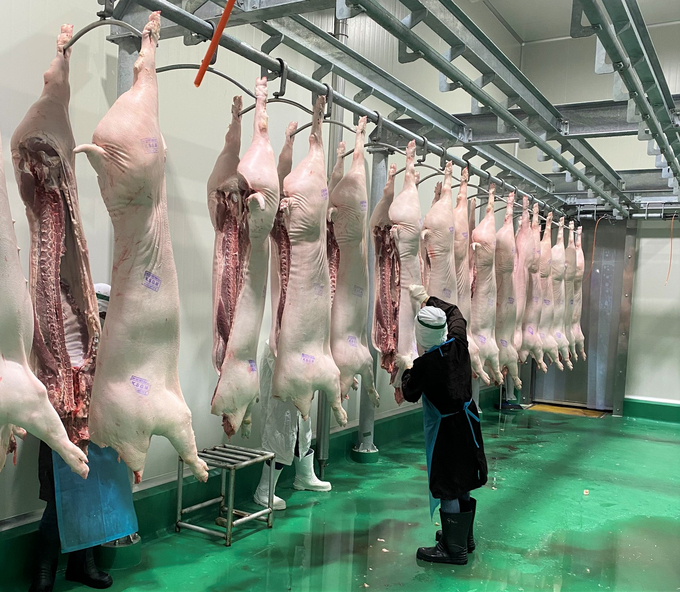November 26, 2025 | 18:24 GMT +7
November 26, 2025 | 18:24 GMT +7
Hotline: 0913.378.918
November 26, 2025 | 18:24 GMT +7
Hotline: 0913.378.918

Concentrated animal slaughterhouse belonging to Vietnam CP Livestock Joint Stock Company - Binh Dinh Branch. Photo: LK .
According to Mr. Huynh Ngoc Diep, General Director of Binh Dinh Sub-Department of Livestock Production and Animal Health, the recently active concentrated slaughterhouses in the province are exhibiting visible efficiency. Namely, there has been 2 slaughterhouses in operation in Quy Nhon City since 2018: Quy Nhon Food Production and Processing Company Limited and Binh Dinh Clean Food Company Limited. These establishments have solved the environmental pollution issues in the city stemming from the slaughter of cattle in the inner residential areas.
With the support of two concentrated animal slaughterhouses, nearly 60 small-scale households specializing in cattle slaughter in Quy Nhon have brought their cattle to concentrated slaughter. As a result, many residential areas have avoided serious pollution. Moreover, 80% of the meat consumed in Quy Nhon originates from these two centralized slaughterhouses. Consequently, the local market for animal products is secured in terms of hygienic practices and food safety.
Vietnam CP Livestock Joint Stock Company - Binh Dinh Branch is one of two concentrated slaughterhouses in An Nhon town, it began operation since the end of December 2022. This establishment slaughters products in the CP's chain to supply to the consumer market in Binh Dinh as well as the CP system nationwide. A slaughterhouse in Nhon An commune, invested and constructed by Quy Nhon Food Processing and Production Company Limited, will officially begin operation in early March.
Mr. Huynh Ngoc Diep emphasized, the 4 concentrated slaughterhouses has helped Binh Dinh control and improve the quality and safety of animal-derived food products in Quy Nhon, An Nhon and Tuy Phuoc, Phu Cat.
According to Mr. Diep, the management and control of active concentrated slaughterhouses has gradually stabilized. Furthermore, the concentrated animal slaughterhouses have raised awareness regarding the importance of safe products for the local people.
“However, investment attraction in this field is challenging. Once a factory has been built, it is very difficult to mobilize small slaughterhouses to bring livestock and poultry into a single concentrated establishment. This issue is caused by long-standing habits and mindset, so the local government must constantly strengthen its information dissemination efforts", shared Mr. Huynh Ngoc Diep.

Products from concentrated animal slaughterhouses to consumers are secured in terms of food hygiene and safety. Photo: DT.
Following the succesful operation of four slaughterhouses, Binh Dinh province has set a target to establish at least one modern animal slaughtering plant in each district, town and city by 2025.
Mr. Dao Van Hung, Deputy Director of Binh Dinh Department of Agriculture and Rural Development, commented that the policy to encourage the construction of concentrated animal slaughterhouses between 2021 and 2025 incorporated many innovations; the policy took effect from the beginning of 2021.
Binh Dinh will take drastic actions during the implementation period. Namely, if a locality fails to call for investors by 2023, they must self-finance to build concentrated animal slaughtering facilities in the area.
According to Mr. Phan Long Dung, Deputy Head of the Economic Department in An Nhon town, the slaughterhouse located in Nhon An will officially begin its operation in March. This is the gathering point for all small-scale slaughterhouses in An Nhon town as well as its surrounding areas of Tuy Phuoc and Phu Cat districts, including 107 households in An Nhon town.
Moreover, the animal slaughterhouse in Nhon An commune is considered a pioneering step towards the goal of ending small-scale slaughter resulting in environmental pollution in residential areas as well as disease control in slaughter operations. When the slaughterhouse operates on the appropriate scale, it will create products that are suitable for the needs of the market in addition to providing meat products that are safe for consumers.
The most challenging aspect to the plan currently is the relocation and support for small slaughterhouses in residential areas to gather in the concentrated establishment. An Nhon town government has directed the establishment of a working group to coordinate with the authorities of the communes and wards to review, compile statistics and promote information so that the local small-scale slaughterhouses understand the policy and its effectiveness in implementation.
Regarding regions without centralized slaughterhouses, Binh Dinh Sub-Department of Livestock Production and Animal Health will coordinate with local authorities to set up working groups and regularly inspect slaughtering activities performed by households, trading points of cattle meat products in wholesale markets before concentrated animal slaughtering establishments are available. So far, the province has 176 registered and licensed animal slaughtering establishments.
Translated by Nguyen Hai Long

(VAN) The model of making a living under the forest canopy through the agroforestry system in Van Son commune, Bac Ninh province, is expected to generate an annual income of approximately VND 30 million/ha.

(VAN) Many enterprises in Can Tho are harnessing natural energy and reducing greenhouse gas emissions in their production processes, thereby contributing to the promotion of a sustainable green transition.
/2025/11/24/3536-2-112800_176.jpg)
(VAN) Dong Nai now has tens of thousands of hectares of forests certified for sustainable management, and this area will continue to be expanded in the coming period.

(VAN) Vinh Ha hamlet (Dai Xuyen commune, Hanoi) is shifting away from small-scale farming as households adopt bioscurity into their breeder chicken models.

(VAN) Heavy rains make aquatic species more vulnerable to disease. Proactive water management and high-tech systems help farmers prevent outbreaks and protect yields.

(VAN) Greenhouses are shifting production mindsets in Binh Lu commune, enabling farmers to ‘weather the sun and rain’ and secure stable vegetable harvests throughout the year.

(VAN) Green transition is crucial for the Mekong Delta amid climate change and stricter standards, offering a path toward sustainability.